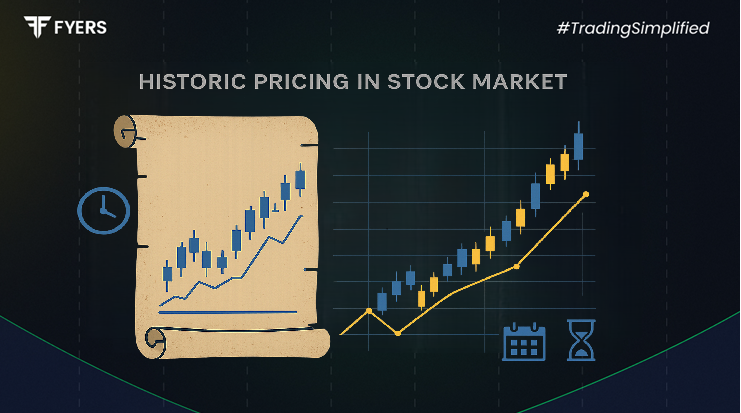

 22 Sep, 2025
22 Sep, 2025
 4 mins read
4 mins read

In the world of investing and trading, decisions are rarely made in isolation. Market participants rely on both past trends and current updates to form strategies. One of the most fundamental tools in this process is historic pricing, which provides a record of how stock prices behaved over time.
For Indian traders and investors, analysing Nifty 50 historical data, NSE historical share price trends, and other long-term datasets can reveal valuable insights into market cycles, volatility, and potential opportunities.
This article explores what historic pricing means, why it matters, and how it can be used effectively.
Historic pricing refers to the recorded values of a stock, index, or asset over a specific period. This includes open, high, low, close prices, and traded volumes across days, weeks, months, or even decades.
For example:
Nifty share price history allows you to see how India’s benchmark index has performed during different market phases.
NSE historical stock data provides long-term performance records of individual companies listed on the exchange.
Such data serves as the foundation for technical analysis, trend forecasting, and even risk management strategies.
While both historic and live market data are useful, they serve different purposes:
Historic pricing shows past performance and helps identify recurring patterns, seasonal trends, or long-term cycles.
Real-time data reflects the current market situation, enabling intraday or short-term decision-making.
Historical prices vs real-time data is not an “either-or” choice. Traders often combine both – using historic data for background research and real-time feeds for execution.
Trend Identification – Helps detect bullish or bearish market cycles.
Risk Management – Past volatility guides traders in setting stop-loss and target levels.
Valuation Analysis – Long-term pricing trends help investors assess whether a stock is undervalued or overvalued.
Backtesting Strategies – Traders can test technical indicators or strategies using historic pricing before applying them live.
Macro Insights – Understanding how indices like Nifty reacted to global crises, policy shifts, or economic growth helps in predicting future outcomes.
Investors and traders can access NSE historical stock data from multiple sources:
NSE India Website – Provides detailed price history for listed securities.
BSE India Website – Historical pricing for companies listed on BSE.
Financial Portals – Platforms like Moneycontrol and Yahoo Finance maintain easy-to-use datasets.
Broker Platforms – Many stockbrokers provide in-built access to NSE historical share price charts and downloadable data.
For deeper analysis, paid data providers also offer adjusted prices, dividend impact data, and advanced analytics.
The Nifty 50 historical data is one of the most widely used benchmarks in India. Analysts rely on it to:
Track how the index has performed during different economic cycles.
Identify resistance and support zones based on past performance.
Compare Nifty share price history with global indices like S&P 500 or Dow Jones.
Evaluate sectoral performance within the index across timeframes.
This helps investors understand the broader market sentiment and align their portfolio strategy accordingly.
Traders use historic pricing in several ways:
Technical analysis – Studying candlestick patterns, moving averages, and support-resistance levels from past data.
Swing and positional trades – Using NSE historical stock data to estimate medium-term entry and exit points.
Algorithmic trading – Backtesting automated strategies against years of past market records.
Event studies – Analysing how share prices moved during policy changes, budget announcements, or global crises.
By applying these insights, traders reduce reliance on speculation and instead base their strategies on evidence.
While valuable, historic pricing comes with certain limitations:
Past performance is not always predictive – Markets evolve with new information.
Structural changes – Regulatory updates, global shifts, or company-specific events can alter price behaviour.
Overfitting risks – Strategies that work in backtesting may not always succeed in real conditions.
Data accuracy – Not all sources provide adjusted data for corporate actions like stock splits or dividends.
Hence, historic data should be combined with real-time market inputs and sound judgement.
Historic pricing plays a crucial role in stock market analysis by providing context to present movements and future expectations. From analysing Nifty share price history to testing strategies with NSE historical stock data, investors and traders can make more informed decisions.
However, it should be used as a guide rather than a guarantee, and always paired with real-time insights. For anyone seeking to improve their market understanding, combining historical prices vs real-time data offers the most balanced perspective.
It is the record of past prices of a stock or index over a defined period, used to study trends and patterns.
It helps investors analyse long-term market cycles, evaluate index performance, and plan trading or investment strategies.
Historic pricing shows past performance for analysis, while real-time data reflects current market movements for execution.
Calculate your Net P&L after deducting all the charges like Tax, Brokerage, etc.
Find your required margin.
Calculate the average price you paid for a stock and determine your total cost.
Estimate your investment growth. Calculate potential returns on one-time investments.
Forecast your investment returns. Understand potential growth with regular contributions.